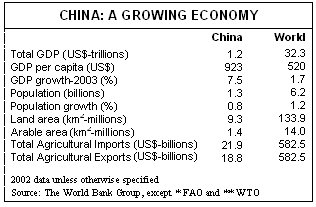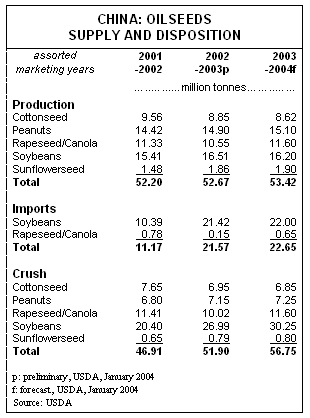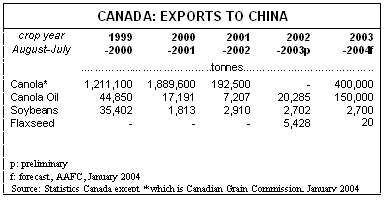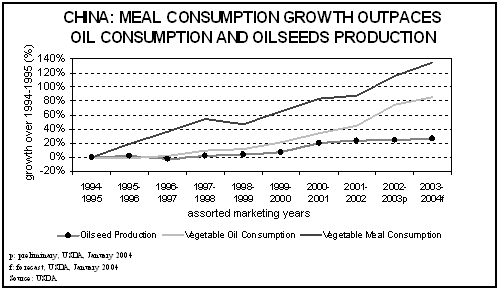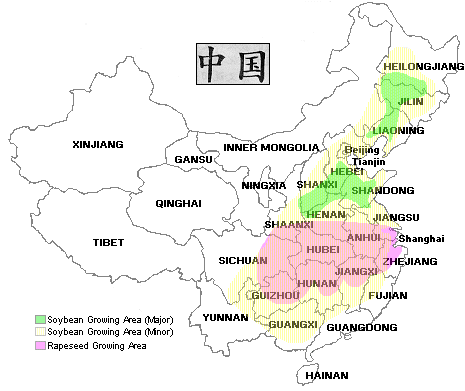Publications: Bi-weekly Bulletin
2004-01-14 | Volume 17 Number 1 | ISSN 1494-1805 | AAFC No. 2081/E
China: Oilseeds Situation and Outlook
The demand for protein meal and vegetable oil in China continues to rise due to the growth in personal income, a strong economy and a growing population. Increased demand for poultry, beef and pork is driving the consumption of meal, which in turn is increasing the demand for soybean imports. Prices for major oilseeds and products are expected to rise by about 30% during 2003-2004, despite record world soybean production. This issue of the Bi-weekly Bulletin examines the situation and outlook for oilseeds in China.
Agricultural Production
China is predominantly an agricultural based society. Approximately 50% of China's workforce is employed in the agricultural sector. Virtually all arable land is used for food crops and China is among the world's largest producers of rice, potatoes, sorghum, millet, barley, peanuts, rapeseed, tea and pork. Major non-food crops include cotton and other fibres.
China maintains its high level of food production by double- and triple-cropping and applying large quantities of fertilizer and labour to its limited land base. While field crop yields are high, China hopes to further increase agricultural yields through improved plant stocks, fertilizer use and technology.
Approximately 40% of China's land is irrigated, compared to a world average of 18%. Unfortunately, many of the irrigation systems in place are not very efficient and result in wasted water. As well, water supplies are dwindling and there is increasing competition for available water from industry and personal consumption. Water is one of the biggest constraints to increasing agricultural production, particularly given the uneven distribution of water between the north, which is drought prone and the south, which is under constant threat of flood.
China's farms are small, with an average size of 1 hectare, and mostly cultivated by households. Farmers do not own, and cannot buy or sell land. Instead, farmland is owned collectively by villages.
The 1998 Land Management Law increased tenure security by providing land use rights for 30 years, and restricting land relocation to small adjustments in isolated cases only. As well, an increasing number of villages now extend full rental rights. Increased land security encourages investment in inputs such as fertilizer and in turn, increases productivity. In December 2003, China's Communist Party's Central Committee submitted a proposal to the National People's Congress to change the constitution to guarantee the right to private property. This would allow farmers to use the land as collateral for bank loans and to transfer land rights, allowing for the creation of larger, more effective farms.
While only 15% of China's land is arable, China is considered to be self sufficient in food production. Agricultural production differs amongst the regions, with soybeans and corn produced in the northeast; wheat, fruit, corn and cotton in the north; rice and fruit on the south coast; rice, rapeseed and meat in the south central region; and, cotton in the west.
Agricultural Policy
China's accession to the World Trade Organization (WTO) in December of 2001 was an important step for the country in its transformation from a centrally-planned economy to a market-focussed and globally-driven economy. In accordance with China's membership in the WTO, the country will lower tariffs, weaken state trading monopolies, increase the openness of import license and quota allocation, and require publication of trade regulations. These commitments will likely reduce the role of government policies and increase the role of market forces in shaping China's agricultural trade.
China is also changing from a largely rural, low technology country into an urbanized, market and consumer-driven economy. As China is the world's largest producer and consumer of agricultural and agri-food products, any changes to China's agricultural and food policies have a profound impact on the world's supply and demand situation.
China continues to be a largely rural country with 63% of the population living in rural areas. Government policies which restricted rural to urban migration in the past have now been relaxed. In general, urban households enjoy a larger income and consume greater quantities of meat, eggs, poultry, milk, fruits and vegetables, and processed foods, while they consume less grains than their rural counterparts. Increased urban migration will lead to further growth in demand for these goods.
Biotechnology Policy
China was a strong proponent for agricultural biotechnology development throughout the 1990s. Taking a more precautionary stance, China's State Council introduced new legislation in May 2001, titled Regulation on Safety Administration of Agricultural Genetically Modified Organisms (GMOs). The regulation stated that China would require safety certification of all domestic and imported GMOs, and labelling of GMOs and processed products containing GMO materials. In early 2002, the Chinese Ministry of Agriculture issued three detailed regulations that addressed the details for bio-safety management, trade and labelling of GMO products. Essentially, the new regulation requires importers and exporters to apply for official safety verification approval from China's Ministry of Agriculture.
Due to the complexity of the changes, China has extended the imposition of new rules governing the import of GMO products until April 20, 2004. Under China's interim GMO rules, domestic importers and foreign suppliers have to apply for GMO safety certificates and labelling permits from the Chinese Ministry of Agriculture, as well as quarantine permits from Administration of Quality Supervision, Inspection & Quarantine before contracts can be signed and cargoes unloaded. Currently the safety certificates are based on field trials performed in the exporting country, but field trials are underway in China and will have to be completed before the new regulations can take effect.
Import Tariffs
China imposes tariffs on most imports, primarily ad valorem. Oilseeds and vegetable oils are subjected to a 13% value added tax (VAT), while vegetable meals are assessed with a 17% VAT. In 1995, China lifted the VAT on soybean meal, resulting in an increase of meal imports, decreased crushing and increased smuggled oil. The VAT was re-imposed in July 1999 and since then there has been an increase in imported soybeans and a decrease in imported products.
Oilseeds and their products also carry an import tariff. Currently, canola and canola meal tariffs, at 9% and 16%, are much higher than the tariffs for soybeans and soybean meal, which are 3% and 9% respectively. The tariffs on vegetable oils, which were prohibitive prior to China's WTO accession, have been negotiated through the use of a Tariff Rate Quota (TRQ).
China's WTO commitments included TRQs for oils, including soybean, rapeseed and palm oil, which it implemented in 2002-2003. An increasing amount of vegetable oil will be imported annually at a preferential in-quota tariff of 9%, while out-of-quota imports face a tariff of 41.6%. The TRQ system will be terminated on January 1, 2006 and, at that time, the tariff on all vegetable oil will be reduced to 9%.
In addition to the TRQ on vegetable oil, China has set trading limits for State Trading Enterprises as a means to encourage a more open and competitive trading environment. Limits were set at 42% for 2002, decreasing to 10% by 2005 for canola oil, soybean oil and palm oil.
Situation: 2003-2004
Oilseeds
China is the third largest oilseeds producer in the world, following the United States (US) and Brazil. It is the world's largest producer of rapeseed, cottonseed and peanuts, while it is the fourth-largest producer of soybeans. Total production of oilseeds (soybeans, rapeseed, peanuts, cottonseed and sunflowerseed) has risen 26% over the past 10 years to reach 53.42 million tonnes (Mt) in 2003-2004. For 2003-2004, production increased 2% over 2002-2003, despite late season rains that negatively impacted some yields, most notably for cottonseed.
In general, production of oilseeds has not kept pace with the growing demand for vegetable oils and protein meals. Imports of soybeans have increased exponentially over the past 10 years, from 155,000 tonnes (t) in 1994-1995 to an expected 22.0 Mt in 2003-2004. China was more or less self-sufficient in soybean production until 1996-1997, when imports began in earnest. For rapeseed/canola, imports were strong between 1998-1999 and 2000-2001, but have since fallen to an expected 650,000 t in 2003-2004.
Chinese oilseed crush has expanded 142% over the past 10 years, with strong growth noted for soybeans, rapeseed/canola and peanuts. In the past five years, almost all of the growth in oilseed crushing has been due to increased crush of imported soybeans. For 2003-2004, China expects to crush 56.8 Mt of oilseeds, a 9% increase over last year.
China has become one of the world's leading crushers of soybeans. Between 1991-1992 and 2003-2004, China's share of world soybean crush capacity increased from 3.7% to 15.5%, surpassing that of the European Union, and Argentina. Historically, small crushing plants were located in the northeast, close to where domestic soybeans were produced, but since the early 1990s, large, modern facilities have been established. Today there are three major regional groupings of oilseed processors. The crushers in northern China process domestically produced soybeans and peanuts; the crushers in the Yangtze Valley, located in south central China, process rapeseed/canola; and, the crushers on the south coast process imported soybeans.
Vegetable Oil
For 2003-2004, total vegetable oil production is expected to reach 12.8 Mt, a 9% increase over last year. The main oils produced in China are soybean oil, rapeseed/canola oil and peanut oil. While the production of soybean oil has doubled over the past five years, the production of rapeseed/canola oil has fallen slightly and the production of peanut oil has remained stable. Smaller amounts of cottonseed oil and sunflowerseed oil are also produced.
Aggregate vegetable oil consumption has risen 85% over the last 10 years, and is expected to reach 17.8 Mt in 2003-2004. A strong economy and rising disposable incomes has led to a significant change in diets. Per capita consumption of vegetable oils in 2003-2004 is forecast at 17.6 kilograms (kg), compared to only 9.6 kg in 1994-1995. Most of this growth in consumption has been in soybean and palm oil, as the consumption of rapeseed/canola oil, peanut oil and other oils has stayed steady.
The potential for future increases in per capita vegetable oil consumption remains strong, as China still lags behind other Asian nations. In 2002, per capita vegetable oil consumption reached 40.8 kg in Hong Kong and 34.9 kg in Taiwan, compared to 15.9 kg in China.
Despite significant investment and tremendous growth in the processing sector, imports have doubled over the past three years to reach 4.9 Mt in 2003-2004. Imports of palm oil have grown substantially over the past five years and are forecast at 3.1 Mt in 2003-2004. Soybean oil imports have also reached a record high. Minimal amounts of rapeseed/canola oil are also imported.
Protein Meal
Remarkable oil meal consumption growth has been achieved through a combination of a change in diets, to include more meat, and a gradual industrialization of feed and livestock production. While the majority of pork and poultry continues to be raised on small-scale farms, there are a growing number of larger operations that rely on commercial feeds with a much higher protein inclusion rate. Meal consumption has increased 135% over the last ten years, to reach 37.4 Mt in 2003-2004. During this same time period, soybean meal consumption has grown 296% and now accounts for 61% of consumption.
China is self sufficient in protein meal production, and only imports limited amounts of soybean meal and fish meal. Exports of soybean meal to neighbouring countries reached about 1 Mt in 2001-2002, but have since fallen.
Prices
Chinese demand for soybeans and a smaller than expected US crop have provided upward support for the complete oilseed complex especially in 2003-2004. Since August 2003, prices for No. 1 Yellow soybeans on the Chicago Board of Trade have surged from US$5.38 per bushel (/bu) to a high of US$7.95 /bu in early January 2004. During this same time frame, Chicago futures prices for soybean meal rose from US$168.80 per short ton (/st) to US$241.80/st, and the soybean oil futures contract price rose from US¢19.77 per pound (/lb) to US¢28.04/lb. To date the cumulative average for 2003-2004 is US$7.23 /bu versus the final average for 2002-2003 of US$5.81/bu.
Landed prices in China have increased even more dramatically due to increased freight rates.
Outlook
For 2004-2005, Chinese imports of oilseeds are projected to increase slightly due to a favourable economic forecast, and the resulting increase in consumption of meats and edible oils. Ongoing investment in the domestic oilseed processing sector, along with government policy that favours importing oilseeds versus oilseed products, will encourage further growth in oilseed imports.
For the next couple of years, however, Chinese imports will be constrained by the availability of ocean freight. China's large demand for commodities, both agricultural and otherwise, is a leading cause of the current increase in freight rates. With fleet utilization at about 96 - 98% and only limited increases in new vessels expected over the next two to three years, further increases in freight rates are expected to ration demand.
Over the medium-term, China's demand for oilseeds is expected to continue to grow. In its Agricultural Outlook to 2012-2013, the Food and Agricultural Policy Research Institute (FAPRI) at the University of Missouri foresees stable production and increased demand for China. Per capita vegetable oil consumption is expected to increase by more than 25% over this ten year period.
For soybeans, FAPRI expects that China's production will stay steady at about 16.5 Mt, as a reduction in area harvested is expected to be offset with an increase in yields. Strong domestic demand will result in continued growth in imports. To date, actual growth in China's soybean imports has outpaced published expectations. By starting with China's actual soybean imports of 21.4 Mt in 2002-2003 and applying FAPRI's implied 6.6% annual growth rate, China's imports of soybeans could rise to 40 Mt by 2012-2013. Over this period, it is also expected that China will increase its exports of soybean meal and decrease its imports of soybean oil.
For rapeseed/canola, Chinese production is forecast by FAPRI to remain similar to 2003-2004 over the next ten years. However, domestic use is also expected to increase by about 2% per year requiring imports of about 2.5 Mt, versus 0.7 Mt for 2003-2004. Rapeseed oil imports are expected to increase to about 300,000 t in 2008-2009, after which they will begin to fall due to expansion of domestic crushing. For rapeseed meal, China is expected to switch from being a minor net exporter to a major net importer over the next five years.
Canada/China Trade
Canada/China partnerships in trade, development, education and culture have grown enormously since the establishment of diplomatic relations in 1970. Canada supported China's accession to the WTO and a Canada-China Bilateral Agreement was signed in November 1999. This agreement called for reduced tariffs on Canadian exports to China with priority given to telecommunications equipment, aircraft, canola oil and paper products.
China is Canada's second largest source of imports. In 2002, Canada imported $16 billion (G) worth of merchandise from China. Canada's main imports included electrical machinery, mechanical appliances, toys, furniture and clothing. Agricultural imports totalled $287 million (M) and included mainly mandarins and seafood.
In 2002, Canada's merchandise exports to China were valued at $4.2G, making China Canada's fourth largest export market, only slightly behind the United Kingdom. Canada's main exports to China were wood pulp, fertilizers, organic chemicals, aircraft and electrical machinery. Agricultural exports, at $284M were down substantially from $841M in 2001, because of the drought in western Canada that reduced exportable supplies. Major agricultural exports in 2002 included wheat, animal fat, barley, hides and dried peas. While absent from the top five exports in 2002, canola is typically the largest agricultural export. In 2002, oilseeds accounted for 13% of Canada's agricultural exports, compared to 48% in 2001 and 2000 and 66% in 1999.
Historically China's imports have been highly variable and this is very true for canola. Canada's exports of canola have averaged 550,000 t over the last 10 years, but have ranged from zero in both 1996-1997 and 2002-2003 to 1.9 Mt in 2000-2001. For 2003-2004, Chinese imports of canola are forecast at 550,000 t, almost three times the amount imported last year. Of this, Canada expects to supply 400,000 t. China's imports of canola fell sharply in 2001, in response to local production, ambiguous GMO policy requirements and local policy initiatives.
Canada currently does not export any canola meal to China, as China does not import any. Canola meal and rapeseed meal are not substitute products. Because of the high levels of glucosinolates in the meal, rapeseed meal can only be fed in small portions to cattle and is considered a poor animal feed. Canola meal, however, is a good substitute for soybean meal in animal rations. Chinese growers can now produce double low-erucic acid rapeseed, which shares canola's characteristics, and growers and processors are realizing the benefits of growing this crop.
Canada also exports small amounts of canola oil, soybeans, and flaxseed.
by
While the Market Analysis Division assumes responsibility for all information contained in this bulletin, we wish to gratefully acknowledge input from the following: Statcom, Market and Industry Services Branch (AAFC)
|
|
||
| Date Modified: 2006-12-08 |
|
|
|
[ Français | Contact Us | Help | Search | Canada Site ] [ AAFC Online | Links | Newsroom | What's New | Site Index ] |
||
